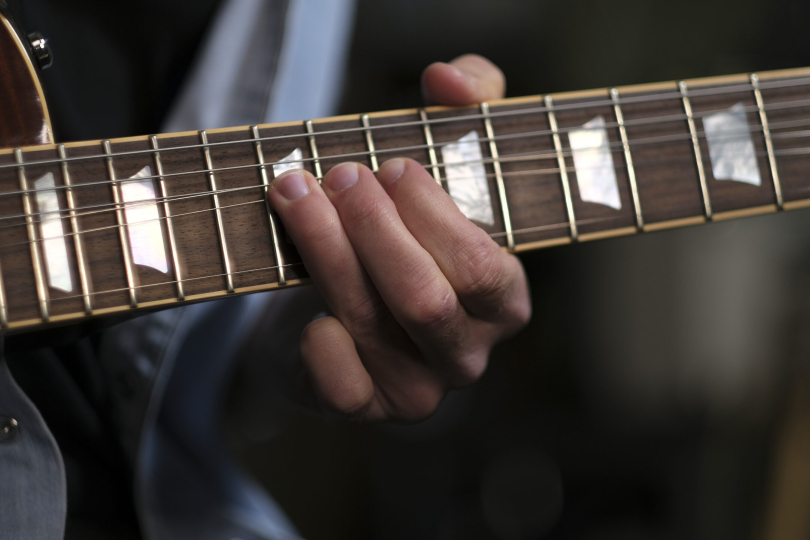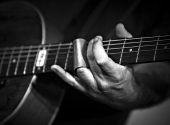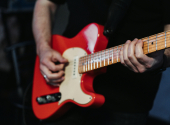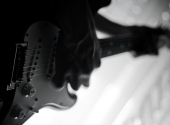
(Un)usual Guitar Techniques #6: String Bending
In this episode of our series on guitar techniques, we delve into the territory where a lot of the special magic that musicians call "feel" occurs. The space where we leave the clear-cut system of the music score and get somewhere, figuratively speaking, between the black and white keys of the piano. When bending strings, we don't create the tone by simply pressing the string at the appropriate fret, but we get to it from a lower position by pulling the string up one or even several semitones. Like vibrato, bending the string adds intensity, tension and emotion to the tone.
However, the tension may sometimes also be read in the guitarist's face. Even though string bending is an essential part of solo playing, it takes a great deal of practice to play the desired note clearly and with the right expression. In fact, this is where guitar playing gets quite close to fretless instruments as guitarists, at least at the beginning, tend to bend the notes by ear, much like violinists.
A brief introduction
It is not the aim of this article to explain the actual string-bending technique in detail, but I will begin with a few recommendations. If you are starting out, watch a few videos and especially focus on the position of your left hand. The string-bending motion is very similar to the one you make when playing vibrato. That means that you are not bending the string only with your finger, but with your entire wrist, and you are moving the string in a circular upward motion. Or a downward motion, as the bass strings on the guitar are bent in the opposite direction, and although bending them is not that common, you'll definitely see it in the blues, for example.
If you are thinking about learning to bend strings, make sure you play the guitar at least semi-regularly. Unless you have hardened fingertips, it can be quite painful. As you know, the strings on the fingerboard are stretched and tight, and bending them adds to that tension, especially if you pull the string up a whole note or more. So it's also a question of strength and the thinner the string, the more it will cut into your fingers.
It's easier to bend the finer strings .009 or .010. On the other hand, you'll have to work quite hard to bend strings on an acoustic guitar, but it's a good exercise. Now let's take a look at some examples of what bent notes can look like and how to use them in solos.
Shine On You Crazy Diamond
Listen to the first few minutes of the following solo and try to notice every bent note... and then imagine that David had played a perfectly normal note instead. The impressive melody would remain, but I daresay at least half of that indescribable magic would be lost. As I mentioned in the introduction, the bent tones allow us to leave the structure of the fingerboard and venture into a landscape of quarter tones, "almost-tones" and "between-tones". A mystical space where it's all about "feeling" and subtle nuances.
Similarly to the vibrato, you can work with the speed of the tones. There are many options, from a slow smooth build-up to a fast, almost imperceptible tone onset. But even if you strum an already bent string and dismiss the characteristic "gliss", the tone's expression and tension will be completely different than if you simply press the string at the appropriate place on the fingerboard. In addition, you can slide out of such a tone by simply releasing the string, which is actually the opposite of a bent tone.
Blue notes
While in a classical solo, you try to bend notes accurately and most of the "feeling" comes from the way you get to the note, in blues it's a bit different. The key is the intonation of the so-called "blue notes". These tones are found in certain places in the blues pentatonic, and if you come across them during a solo, it's a good idea to bend them a bit. The "a little" is crucial though. There's no rule saying how much to bend the note, but there's only one place where it's right. That's where you have to rely on your ears.
For those of you who like structure and clear rules, this vagueness can be a little unnerving. You can start by listening to the way blues guitarists play these notes and try to imitate them. Over time, you'll develop a feel for the exact amount of "blue tone" bending, and you might start to enjoy this strange freedom.
In the case of the blues, the bent tones allow us just the right amount of imperfection and liveliness that the genre needs to be what it should be.
As Guthrie Govan says somewhat mischievously in the opening video, string bending is something that keyboardists must quietly envy. It's a technique that lets us cross boundaries and explore new musical worlds. It's definitely worth trying out and exploring further. We will be delighted if today's article inspires you to do the same.
If you have found an error or typo in the article, please let us know by e-mail info@insounder.org.





